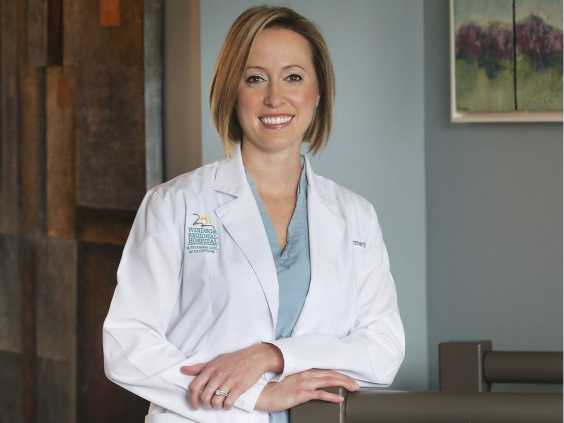Apr 28, 2020

Dr. Jessica Summerfield is shown at her Tecumseh, ON. home on Friday, April 24, 2020.
She has been on the front line of the local COVID-19 pandemic battle. DAN JANISSE
Jessica Summerfield kissed her little girls, squeezed them in her arms and turned away clenching back tears, wondering when she might see them again.
The Windsor doctor was in Florida with her family when COVID-19 took hold in Canada and preparations to fight it were ramping up. She booked a flight home.
Since then, it’s been a daily repeat of guilt for leaving her family, worry for her colleagues, fear of being infected herself and an “unshakeable anxiety” knowing each new dawn could bring an overwhelming flood of COVID-19 patients.
“It’s almost like a sense of impending doom driving in every day, wondering if today will be the day we become completely overwhelmed, if our resources can’t keep up with the demand,” said Summerfield, 37, a family doctor and hospitalist. “We’ve been anticipating this surge, this overwhelming flood of sickness in the community that hasn’t yet come. We’re wondering if maybe our isolation has worked, which we’re hopeful for. We’re also worried that it’s still coming.”
She said Monday it had been 47 days since she last saw her family. In mid-March, Summerfield was in Orlando with her husband, Carl, and their seven-year-old twins, Kate and Evy, looking forward to a “Disney World adventure.” COVID-19 put a quick end to those plans.
Summerfield and her husband decided she should remain isolated from the family — especially the kids — because of the risk she faces every day of getting infected.
“They say they miss me,” said Summerfield, who recently wrote an essay for the Ontario Medical Association about her pandemic experience in Windsor. “They say, ‘How are the sick people at the hospital? Are they getting better?’”
They also wonder when the family can be reunited.
She has pangs of guilt for leaving her children during the pandemic. But risking bringing the virus home to them was not an option. Neither was sitting back while her colleagues fought the battle without her.
“It’s no surprise that physicians in particular, we sacrifice time with our families, holidays with our families, bedtime stories with our families because our phones are ringing, our pagers are going off,” said Summerfield. “Our family is constantly pushed to the side for work. This is yet another time I’ve had to push my family to the side because of the nature of my career. There’s an element of guilt to that.”
She left her children splashing in the hotel swimming pool. After a last few hugs, she headed for the exit, not wanting her daughters to see her fighting back tears.
“I tried not to cry,” said Summerfield. “The girls were OK. They were in vacation mode. I just hugged them goodbye and told them I loved them and told them I would see them shortly.”
She spent her first day back home working in Windsor Regional Hospital’s COVID-19 assessment centre.
“A lot of strategic planning as far as rolling out the COVID assessment centre, coming up with scheduling, how we would have patients flow through the hospital system,” said Summerfield. “A lot of meetings trying to get ourselves organized.”
She then went to her office to see patients who needed vaccinations, were urgently unwell or required other “essential visits.”
Her family practice later started doing virtual visits for patients over the phone when suitable.
Since her return from Florida, she has been on-call and worked in the hospital every day except for two. She’s usually there by 6:30 a.m.
“It feels like Groundhog Day,” she said. “Every day is the same. I wake up. Eat breakfast. Go to work. Do my rounds. Meet with the team. Then come home and call patients from home, answer emails. Go to bed and repeat. Just reading a lot about COVID, preparing for the worst and hoping for the best.”
Even among the medical professionals trained to deal with such a health crisis, that fear of the worst has taken its toll.
“There’s definitely an increased level of anxiety,” said Summerfield. “You feel a lot of physical distance, not just because you’re trying to distance yourself. But everyone’s afraid — are you an asymptomatic carrier? Are we infected? Do you have it? Do I have it? Let’s not get too close.”
Everyone is shrouded in masks, shields and gowns, adding a surreal layer of awkwardness to the already tense situation.
“You can’t see each other’s faces,” said Summerfield. “You can only see each other’s eyes. It’s really hard to read non-verbals. Even speaking to families on the phone. Their anxiety is high. You’re trying to reassure them but you have no non-verbal feedback to know if they’re understanding. Are they overwhelmingly stressed? Are they satisfied? Dissatisfied with your care? It’s a completely different way of practice than we’re used to. Yet we just adapt and keep moving forward.”
Despite the barriers and physical distance, she said the hospital team has never been closer.
“Even though it’s scary and anxiety-provoking, there’s a sense of collegiality that’s very strong,” said Summerfield. “There is a real sense of kinship with the staff and the physicians, and a closeness that I’ve never actually felt so much before as kind of like a feeling that we’re in it together.”
Courtesy: https://windsorstar.com/news/local-news/windsor-doctor-describes-life-on-the-front-lines-of-the-covid-19-crisis/



